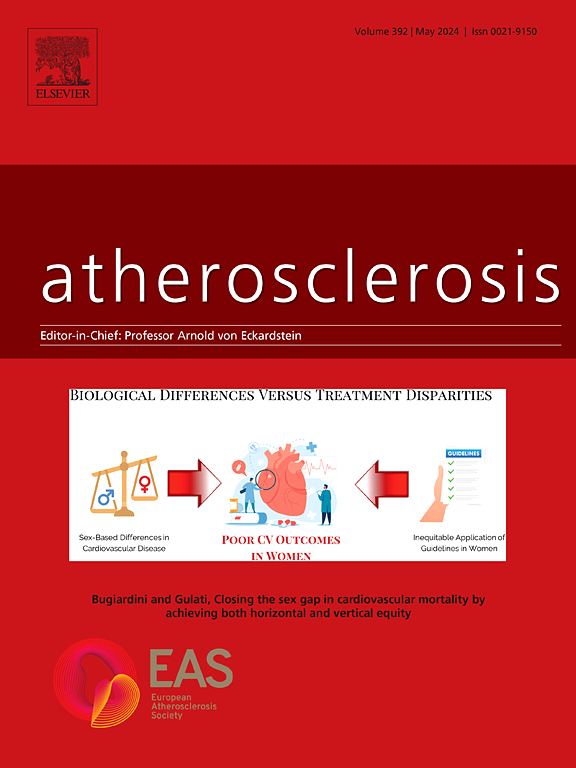Sex related coronary plaque progression patterns among patients with family history as the sole cardiovascular risk factor: A PARADIGM sub-study
IF 4.9
2区 医学
Q1 CARDIAC & CARDIOVASCULAR SYSTEMS
引用次数: 0
Abstract
Background and aims
How sex may influence the prevalence and progression of coronary atherosclerosis in patients with positive family history for CAD is still unclear. Aim of the present study was to explore the role of family history of CAD in coronary atherosclerosis expression and progression in male and female subjects.
Methods
A total of 2252 patients who underwent clinically indicated serial CCTAs at an interscan interval of more than 2 years were enrolled in the PARADIGM Study. For the present sub-analysis, a selected population was identified after applying the following exclusion criteria:1)uncomplete plaque analysis data; 2)occurrence of any MACE between CT scans; 3) positive history for coronary artery disease before the first CT scan; 4) the presence of any traditional risk factors a part from positive family history of CAD. Subjects enrolled were classified according to family history of CAD status and separate analysis for male and female were performed.
Results
Among 210 subjects finally enrolled, no differences in annual total plaque progression according to family history of CAD were detected even when plaque subtypes were evaluated. On the contrary, an higher annual fibrous-fatty plaque progression was evident only among male subjects with family history of CAD [0.3 mm3(IQR 0–3.7) vs 0 mm3(IQR -0.5–0.9), p = 0.0302 for patients with vs without family history respectively] but not among female. At multivariate analysis significative annual fibrous-fatty plaque progression was recorded only among male with family history [OR 3.29(95 % CI 1.05–10.35),p = 0.0412].
Conclusions
Family history of CAD resulted to be associated with rapid high risk plaque volume progression among males but not among females.

家族史为唯一心血管危险因素的患者中与性别相关的冠状动脉斑块进展模式:一项范式亚研究
背景和目的性别是否会影响冠心病家族史阳性患者冠状动脉粥样硬化的患病率和进展尚不清楚。本研究旨在探讨冠心病家族史在男性和女性受试者冠状动脉粥样硬化表达和进展中的作用。方法范式研究共纳入2252例在扫描间隔超过2年的时间内接受临床指示的连续ccta的患者。在本亚组分析中,在应用以下排除标准后确定了一个选定的人群:1)斑块分析数据不完整;2) CT扫描之间有无MACE;3)首次CT扫描前有冠状动脉病史;4)任何传统危险因素的存在都是CAD阳性家族史的一部分。根据冠心病家族史对入组受试者进行分类,分别对男性和女性进行分析。结果在最终纳入的210名受试者中,即使在评估斑块亚型时,也没有发现根据CAD家族史的年度总斑块进展差异。相反,只有有CAD家族史的男性受试者的纤维脂肪斑块的年进展明显更高[0.3 mm3(IQR 0 - 3.7) vs 0 mm3(IQR -0.5-0.9),有与无家族史患者的p = 0.0302],而女性则没有。在多变量分析中,仅在有家族史的男性中记录了显著的纤维脂肪斑块年度进展[OR 3.29(95% CI 1.05-10.35),p = 0.0412]。结论冠心病家族史与男性高危斑块体积的快速进展有关,而与女性无关。
本文章由计算机程序翻译,如有差异,请以英文原文为准。
求助全文
约1分钟内获得全文
求助全文
来源期刊

Atherosclerosis
医学-外周血管病
CiteScore
9.80
自引率
3.80%
发文量
1269
审稿时长
36 days
期刊介绍:
Atherosclerosis has an open access mirror journal Atherosclerosis: X, sharing the same aims and scope, editorial team, submission system and rigorous peer review.
Atherosclerosis brings together, from all sources, papers concerned with investigation on atherosclerosis, its risk factors and clinical manifestations. Atherosclerosis covers basic and translational, clinical and population research approaches to arterial and vascular biology and disease, as well as their risk factors including: disturbances of lipid and lipoprotein metabolism, diabetes and hypertension, thrombosis, and inflammation. The Editors are interested in original or review papers dealing with the pathogenesis, environmental, genetic and epigenetic basis, diagnosis or treatment of atherosclerosis and related diseases as well as their risk factors.
 求助内容:
求助内容: 应助结果提醒方式:
应助结果提醒方式:


